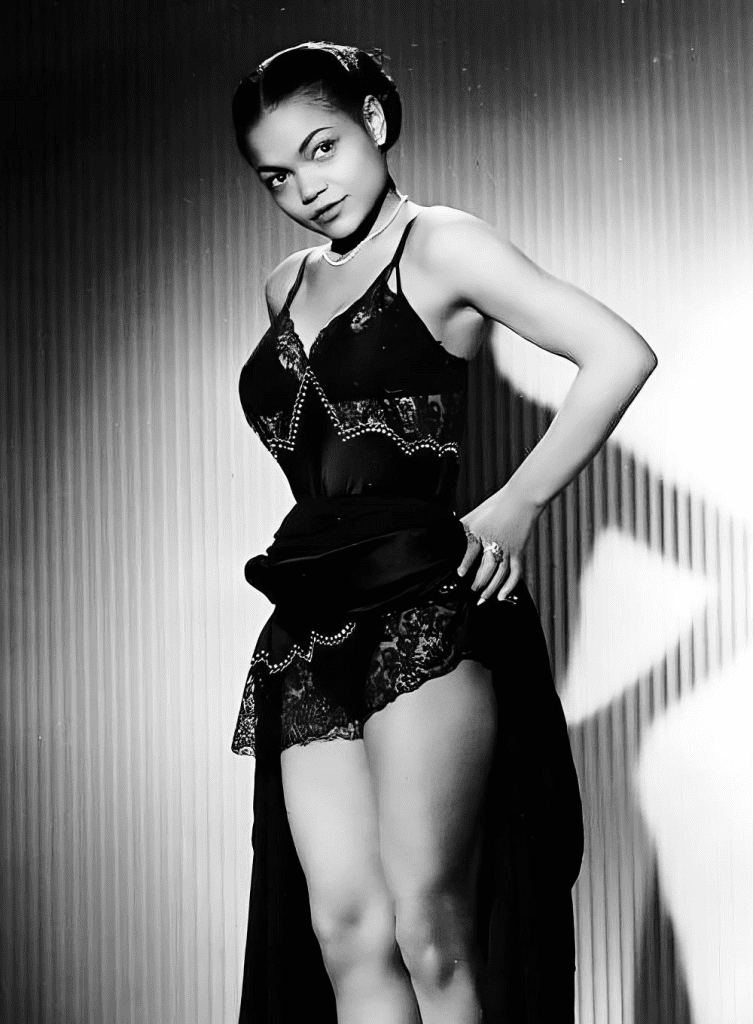Eartha Kitt remains one of the most captivating and mysterious figures in entertainment history, known for her sultry voice, commanding stage presence, and bold personality. From her famed rendition of “Santa Baby” to her iconic role as Catwoman, Kitt was a woman of immense talent and unbreakable resilience. However, beneath her glamorous exterior lay a story of hardship and pain that few truly know. Eartha Kitt’s life was shaped by poverty, rejection, and a relentless search for identity—elements that fueled her remarkable career and unforgettable persona.

Early Life: Born into Poverty and Abandonment
Eartha Kitt was born on January 17, 1927, in the small town of North, South Carolina. Her life began in hardship. She was the daughter of an African American and Cherokee mother and a white father whose identity she never fully knew. This mixed-race heritage isolated Kitt from her community, as she faced discrimination from both Black and white individuals who referred to her as a “yellow gal”—a term used derogatorily for light-skinned Black people.
Her mother abandoned her at a young age, leaving Kitt in the care of relatives who mistreated and abused her. These relatives subjected her to physical and emotional abuse, leaving scars that stayed with her for life. Around the age of eight, she moved to New York City to live with her aunt. It was here, amidst the bustling city, that her talent began to blossom.
Rising Talent: From Dance Troupe to Paris Nightclubs
In New York, Kitt attended the High School of Performing Arts, where she discovered her passion for performing. By sixteen, she earned a scholarship to study dance with Katherine Dunham, a pioneering Black choreographer. Joining Dunham’s dance troupe, Kitt toured internationally, and it was in Paris where her career truly took off. Performing in Parisian nightclubs, she captivated audiences with her unique voice and magnetic stage presence.
Eartha Kitt was soon discovered by Orson Welles, who famously dubbed her “the most exciting woman alive” and cast her as Helen of Troy in his production of Dr. Faustus. This endorsement helped Kitt’s career skyrocket, leading her back to the United States, where she would make waves on Broadway and in Hollywood.
Career Highlights: From “Santa Baby” to the Silver Screen
Eartha Kitt’s breakthrough moment came in the 1952 Broadway revue New Faces of 1952, where she performed “Monotonous.” This performance launched her music career, and in 1953, she recorded her first album, featuring hits like “I Want to Be Evil,” “C’est Si Bon,” and, of course, the holiday classic “Santa Baby.” Her playful, seductive voice brought a new level of allure to music, earning her fans around the world.
In 1958, Kitt starred alongside Nat King Cole in St. Louis Blues, and the following year, she received an Academy Award nomination for her role in Anna Lucasta, opposite Sammy Davis Jr. Kitt’s on-screen performances showcased her range and depth, proving she was more than just a singer—she was a bona fide actress with a unique charisma.

Catwoman and Controversy: Eartha Kitt’s Iconic TV Role
In the 1960s, Kitt took on one of her most memorable roles, playing the sultry and villainous Catwoman on the TV series Batman. Taking over the role from Julie Newmar, Kitt’s portrayal of Catwoman left an indelible mark on pop culture. Her distinctive voice, combined with her cat-like grace, made her the definitive Catwoman for a generation. Remarkably, she only appeared in a handful of episodes, but her performance remains iconic.
In 1968, Kitt’s outspoken nature brought her career to a standstill. During a White House luncheon on juvenile delinquency hosted by First Lady Lady Bird Johnson, Kitt openly criticized the Vietnam War, stating, “You send the best of this country off to be shot and maimed. No wonder the kids rebel and take pot.” Her remarks infuriated the Johnson administration and ignited a media storm. As a result, Kitt was blacklisted in the United States and was forced to continue her career overseas for several years.
A Career Comeback: Finding New Success on Broadway
Despite the setback, Kitt returned to the American stage in 1978 with a Tony-nominated performance in the Broadway musical Timbuktu! Her role led to new opportunities, including an invitation to the White House by President Jimmy Carter. In 1984, she achieved renewed musical success with her hit single “Where Is My Man,” proving she was far from finished. In 1994, her album Back in Business earned her a Grammy nomination, and she continued to dazzle audiences with her powerful voice and charisma.
Kitt’s resilience was an inspiration. She continued performing well into her seventies, appearing on Broadway, recording music, and even winning a Daytime Emmy Award in 2000 for her voice work on Disney’s The Emperor’s New School.

Personal Struggles: Searching for Identity and Family
Though Eartha Kitt achieved fame, her personal life remained haunted by her past. She never knew the identity of her father and faced rejection from her community due to her mixed-race heritage. At 71, she obtained her birth certificate, only to find that her father’s name was blacked out. This discovery deeply saddened her, as it confirmed a painful suspicion that she had carried throughout her life—that her father’s identity was deliberately kept secret, likely because he was a white man.
Her daughter, Kitt Shapiro, revealed that her mother often struggled with feelings of isolation, even into her adult years. This rejection by both Black and white communities left a permanent mark on her, shaping her fierce independence and strength.
Legacy and Final Years: A Star That Continued to Shine
Eartha Kitt’s final years were marked by professional success and personal fulfillment. She frequently performed her cabaret act in New York’s famed Café Carlyle, mesmerizing audiences with the same energy and allure she had displayed throughout her career. In 2006, Kitt was diagnosed with colon cancer, a disease she battled quietly until her passing on December 25, 2008.
To honor her legacy, her daughter Shapiro launched Simply Eartha, a brand that keeps her mother’s memory alive. Eartha Kitt remains an enduring icon of grace, talent, and resilience—a woman who defied the odds and left an indelible mark on the entertainment industry.
Conclusion: Eartha Kitt’s Unbreakable Spirit
Eartha Kitt’s life was one of extraordinary highs and lows. From a troubled childhood to the heights of fame, she became a cultural icon whose voice and presence captivated audiences around the world. Despite the challenges she faced—both personal and professional—Kitt’s resilience and determination allowed her to rise above them, leaving a legacy of courage, creativity, and unapologetic self-expression. Eartha Kitt’s story reminds us of the strength that can come from adversity and the power of staying true to oneself, no matter the cost.


